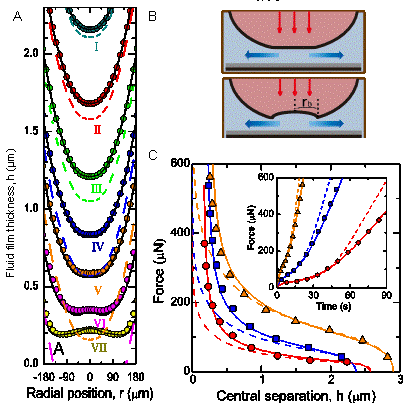Reports: ND551803-ND5: Role of Drainage Channels on Lubrication Forces
Joelle Frechette, Johns Hopkins University
Overview:
The ACS-PRF grant (type ND) has helped support our efforts to understand the role of interconnected vertical channels and elastic deformation on the fluid pressure necessary to separate (move) two surfaces, an important issue for the petroleum industry and to hydrofracturing more specifically. The ACS-PRF-supported work has led to additional funding from the National Science Foundation. Additionally, three peer-reviewed publications have acknowledged ACS-PRF in the last year.
Summary of Activities:
Role of interconnected vertical channels, surface heterogeneities, and elasticity on drainage.
Rock masses contain complex and interconnected fracture networks, which are important for oil recovery, groundwater resources, and the generation of power from geothermal sources.1 Hydrofracture is a practice in which fluid pressure causes the initiation or propagation of a crack in a reservoir. This practice is commonly employed for secondary and tertiary oil recovery where water at high pressure is inserted into a well to increase its productivity. Important fundamental questions relevant to hydraulic fracturing are 1) What is the necessary fluid pressure to initiate or propagate a fracture? 2) What is the timescale for this process? and 3) How to ensure that the fluid injected will not only open the pore space but will also allow for oil recovery in all the interconnected channels forming the porous material?
Findings. We performed direct measurements of the hydrodynamic forces and measured the spatiotemporal elastic deformation during the approach of an elastic half-space toward another surface in a viscous fluid (Fig. 1A-B).2 We observed that elastic deformation causes the formation of a dimple at the center and prevents contact to be reached (Fig. 1B). With a thinner elastic film the stress becomes increasingly supported by the underlying rigid substrate and the dimple formation is suppressed, which allows the surfaces to reach full contact. We highlight the lag due to viscoelasticity on the surface profiles, and that for a given fluid film thickness deformation leads to stronger hydrodynamic forces than for rigid surfaces (Fig. 1C).
In a separate study we designed surface with well-defined surface heterogeneities that can be used to study adhesion and fracture. We developed a chemical vapor deposition method to pattern mica surfaces with regions of high-quality aminosilane monolayers3. The approach relies on the vapor deposition of an aminosilane through a patterned array of through-holes in a PDMS (poly(dimethylsiloxane)) membrane that acts as a mask. In aqueous solutions the surfaces have regular patterns of charge heterogeneities with minimal topographical variations over large areas. This versatile dry lift-off deposition method alleviates issues with multilayer formation and can be used to create charge patterns on curved surfaces. We identify the necessary steps to achieve high quality monolayers and charge reversal of the underlying mica surface. AFM imaging shows that the monolayers have a height of (0.9 ± 0.2) nm with an increase in height up to 3nm at the mica–membrane-vapor contact lines. Fluorescence imaging demonstrates pattern fidelity on both flat and curved surfaces, for feature sizes that vary between 6.5-40 µm.
Fig. 1. (A) Experimental and theoretical spatiotemporal surface profile during approach at V = 137 nm/s. The black solid lines correspond to theoretical predictions Time stamps are: I: t = 3.8s, II: t = 8.8s, III: t = 13.8s, IV: t = 18.8s, V: t = 23.8s, VI: t = 33.8s, and VII: t = 53.8s. Dash lines are for the positions of the corresponding undeformed sphere. (B) Illustration of the geometry and deformation profile during the approach. (C) Repulsive elastohydrodynamic force as a function of central separation, h. Circles: V = 69 nm/s, squares: V = 137 nm/s, triangles: V = 355 nm/s. Dash lines: predictions for rigid surfaces, solid lines: predictions for compliant surfaces treating the elastomer as a viscoelastic solid. Inset: corresponding force as a function of time.
Fig. 2. (Top) Patterned APTES monolayers on mica. (Bottom) Left double layer force measurements of surfaces with APTES monolayers, and Right AFM imaging of the surface patterns.
[1] Council, Rock fractures and fluid flow: Contemporary understanding and applications, National Academy Press, Washington, DC, 1996.
[2] Wang, Physical review letters 2015, 115, 248302.
[3] a) Pick, Langmuir 2015; b) Pick, Langmuir 2015, 31, 10725.













